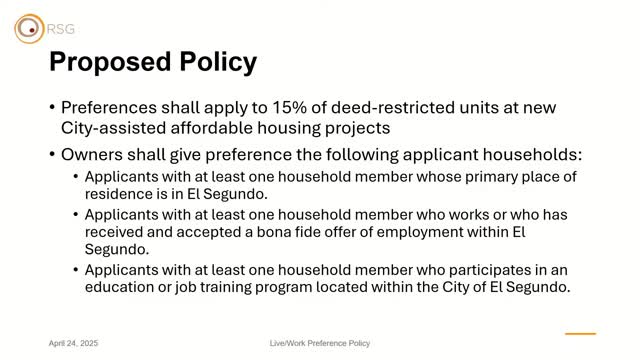Council discusses affordable housing preferences to mitigate displacement in future projects
April 26, 2025 | El Segundo City, Los Angeles County, California
This article was created by AI summarizing key points discussed. AI makes mistakes, so for full details and context, please refer to the video of the full meeting. Please report any errors so we can fix them. Report an error »

In a recent Planning Commission meeting held on April 24, 2025, the El Segundo City Council discussed critical strategies to address the pressing issue of affordable housing in the community. A significant focus was placed on the proposed allocation of 15% of affordable housing units to local residents, including police officers, firefighters, teachers, and other essential workers.
The council members expressed concerns about whether this 15% allocation would be sufficient to meet the needs of the community. With the current housing crisis, many believe that the number may be too low, especially given the high demand for affordable housing. The discussion highlighted the importance of ensuring that those who live and work in El Segundo have the opportunity to remain in the area, thereby mitigating displacement and fostering a sense of community.
Council members also raised questions about the monitoring of applications for these affordable units. It was noted that while there are no current projects in place, future city-assisted developments would require a robust system to ensure that the preferences are enforced. The council is considering options for oversight, which may involve contracting with external agencies to manage the application process and ensure compliance.
The conversation underscored the dual goals of the affordable housing initiative: to prevent displacement of current residents and to promote environmental sustainability by reducing vehicle miles traveled (VMT). By enabling residents to live closer to their workplaces, the city aims to alleviate traffic congestion and enhance community cohesion.
As the council moves forward, the need for a comprehensive approach to affordable housing remains clear. The discussions from this meeting will play a crucial role in shaping future policies and projects aimed at addressing the housing needs of El Segundo residents. The council's commitment to revisiting the 15% allocation and exploring additional measures reflects a proactive stance in tackling one of the community's most significant challenges.
The council members expressed concerns about whether this 15% allocation would be sufficient to meet the needs of the community. With the current housing crisis, many believe that the number may be too low, especially given the high demand for affordable housing. The discussion highlighted the importance of ensuring that those who live and work in El Segundo have the opportunity to remain in the area, thereby mitigating displacement and fostering a sense of community.
Council members also raised questions about the monitoring of applications for these affordable units. It was noted that while there are no current projects in place, future city-assisted developments would require a robust system to ensure that the preferences are enforced. The council is considering options for oversight, which may involve contracting with external agencies to manage the application process and ensure compliance.
The conversation underscored the dual goals of the affordable housing initiative: to prevent displacement of current residents and to promote environmental sustainability by reducing vehicle miles traveled (VMT). By enabling residents to live closer to their workplaces, the city aims to alleviate traffic congestion and enhance community cohesion.
As the council moves forward, the need for a comprehensive approach to affordable housing remains clear. The discussions from this meeting will play a crucial role in shaping future policies and projects aimed at addressing the housing needs of El Segundo residents. The council's commitment to revisiting the 15% allocation and exploring additional measures reflects a proactive stance in tackling one of the community's most significant challenges.
View full meeting
This article is based on a recent meeting—watch the full video and explore the complete transcript for deeper insights into the discussion.
View full meeting
